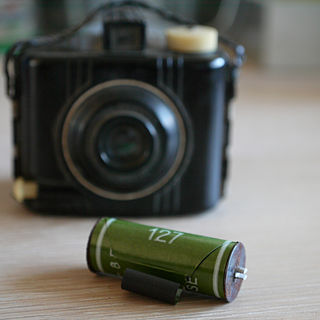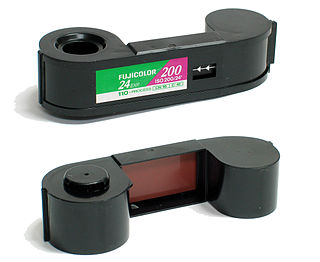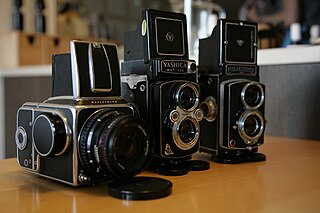
35 mm film is a film gauge used in filmmaking, and the film standard. In motion pictures that record on film, 35 mm is the most commonly used gauge. The name of the gauge is not a direct measurement, and refers to the nominal width of the 35 mm format photographic film, which consists of strips 1.377 ± 0.001 inches (34.976 ± 0.025 mm) wide. The standard image exposure length on 35 mm for movies is four perforations per frame along both edges, which results in 16 frames per foot of film.

A camera is an instrument used to capture and store images and videos, either digitally via an electronic image sensor, or chemically via a light-sensitive material such as photographic film. As a pivotal technology in the fields of photography and videography, cameras have played a significant role in the progression of visual arts, media, entertainment, surveillance, and scientific research. The invention of the camera dates back to the 19th century and has since evolved with advancements in technology, leading to a vast array of types and models in the 21st century.
The following list comprises significant milestones in the development of photography technology.

135 film, more popularly referred to as 35 mm film or 35 mm, is a format of photographic film used for still photography. It is a film with a film gauge of 35 mm (1.4 in) loaded into a standardized type of magazine – also referred to as a cassette or cartridge – for use in 135 film cameras. The engineering standard for this film is controlled by ISO 1007 titled '135-size film and magazine'.

120 is a film format for still photography introduced by Kodak for their Brownie No. 2 in 1901. It was originally intended for amateur photography but was later superseded in this role by 135 film. 120 film survives to this day as the only medium format film that is readily available to both professionals and amateur enthusiasts.

127 is a roll film format for still photography introduced by Kodak in 1912.

126 film is a cartridge-based film format used in still photography. It was introduced by Kodak in 1963, and is associated mainly with low-end point-and-shoot cameras, particularly Kodak's own Instamatic series of cameras.

110 is a cartridge-based film format used in still photography. It was introduced by Kodak in 1972. 110 is essentially a miniaturized version of Kodak's earlier 126 film format. Each frame is 13 mm × 17 mm, with one registration hole. Cartridges with 12, 20, or 24 frames are available on-line. Production variations sometimes have allowed for an additional image.

Advanced Photo System (APS) is a discontinued film format for still photography first produced in 1996. It was marketed by Eastman Kodak under the brand name Advantix, by FujiFilm under the name Nexia, by Agfa under the name Futura and by Konica as Centuria.

Medium format has traditionally referred to a film format in photography and the related cameras and equipment that use film. Nowadays, the term applies to film and digital cameras that record images on media larger than the 24 mm × 36 mm used in 35 mm photography, but smaller than 4 in × 5 in.

Kodachrome is the brand name for a color reversal film introduced by Eastman Kodak in 1935. It was one of the first successful color materials and was used for both cinematography and still photography. For many years, Kodachrome was widely used for professional color photography, especially for images intended for publication in print media.

An instant camera is a camera which uses self-developing film to create a chemically developed print shortly after taking the picture. Polaroid Corporation pioneered consumer-friendly instant cameras and film, and were followed by various other manufacturers.

In photography, reversal film or slide film is a type of photographic film that produces a positive image on a transparent base. Instead of negatives and prints, reversal film is processed to produce transparencies or diapositives. Reversal film is produced in various sizes, from 35 mm to roll film to 8×10 inch sheet film.

Large format refers to any imaging format of 9 cm × 12 cm or larger. Large format is larger than "medium format", the 6 cm × 6 cm or 6 cm × 9 cm size of Hasselblad, Mamiya, Rollei, Kowa, and Pentax cameras, and much larger than the 24 mm × 36 mm frame of 35 mm format.

Instant film is a type of photographic film that was introduced by Polaroid Corporation to produce a visible image within minutes or seconds of the photograph's exposure. The film contains the chemicals needed for developing and fixing the photograph, and the camera exposes and initiates the developing process after a photo has been taken.

Technical Pan is an almost panchromatic black-and-white film that was produced by Kodak. While it can reproduce the visible light spectrum, it leans to the red, and so unfiltered outdoor shots render blues, most notably the sky, with additional darkening and reds with some lightening. It was generally used as a very slow film, rated at EI 25 or even 16, although it could be rated at up to EI 320 with a distinct loss of tonal range and a bunching of shadow and highlight detail. This film has unmatched fine grain, especially when rated at a low speed, and makes excellent enlargements while preserving fine details. Kodak stopped selling it in 2004. It has not been replaced by a film with its characteristics. Although some of its particularities were unique and no emulsion in actual production could replace it, its resolution capabilities were surpassed by another film by ADOX, CMS 20 II.

828 is a film format for still photography. Kodak introduced it in 1935, only a year after 135 film. 828 film was introduced with the Kodak Bantam, a consumer-level camera.

Analog photography, also known as film photography, is a term usually applied to photography that uses chemical processes to capture an image, typically on paper, film or a hard plate. These processes were the only methods available to photographers for more than a century prior to the invention of digital photography, which uses electronic sensors to record images to digital media. Analog electronic photography was sometimes used in the late 20th century but soon died out.

Half-frame cameras, also called single-frame or split-frame cameras, are analog cameras compatible with 35mm film types. These cameras capture congruent shots that take up half of each individual frame in the roll of film. They can be still frame or motion picture cameras and are the standard format of 35mm movie cameras. This is commonly expressed, more technically, as 18×24 mm using 18×24 mm of a regular 135 film. It is closer to the normal frame size of a 35 mm motion film. This leaves half frame cameras to derive their film plate size from the aspect ratio, and frame size that was first designated by Thomas Edison at the dawn of the motion picture industry. Traditionally, the additional film width on motion picture film is used for audio in later film standards, although the original patent for sound on film is derived from the 1880s.

Photographic film is a strip or sheet of transparent film base coated on one side with a gelatin emulsion containing microscopically small light-sensitive silver halide crystals. The sizes and other characteristics of the crystals determine the sensitivity, contrast, and resolution of the film. Film is typically segmented in frames, that give rise to separate photographs.



















